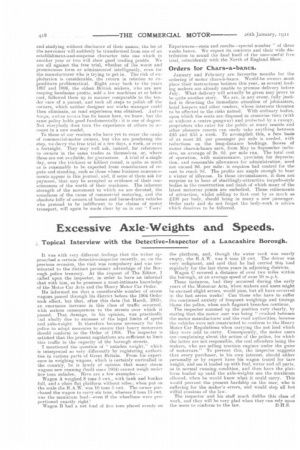Excessive Axle-Weights and Speeds.
Page 2

If you've noticed an error in this article please click here to report it so we can fix it.
Topical Interview with the Detective-Inspector of a Lancashire Borough.
It was with very different feelings that The writer approached a certain detective-inspector recently, as, on the previous occasion, the visit was compulsory and was terminated to the distinct pecuniary advantage of the Borough police treasury. At the request of The Editor, 1 called upon the inspector, in order to have an informal chat with him, as he possesses a most-intimate knowledge of the Motor Car Acts and the Heavy Motor Car Order.
He informed me that a considerable number of steam wagons passed through his district before the 1904 Order took effect, but that, after this date (let March, 1905,) an enormous increase in this class of traffic occurred, with serious consequences to the streets over which it passed. That damage, in his opinion, was practically abd wholly due to excesses of the legal limits of speed and axle-weight _ It therefore became necessary for the police to adopt measures to ensure that heavy motorcars should conform to the Order of 1904. The inspector is satisfied that the present regulations are sufficient to limit this traffic to the capacity of the borough streets. T mentioned the question of " unladen weight," which is interpreted so very differently by registering authorities in various parts of Great Britain. From his experience in weighing wagons, which is certainly unrivalled in the country, he is firmly of opinion that many steam wagons now running (built since 1904) cannot weigh under five tons unladen. Here are a few examples:—
Wagon A. weighed 8 tons .5 cwt., with tank and bunker full, and a plain flat platform without sides; when put on the scale the R.A.W. was 10 tons 5 cwt. The owner purchased the wagon to carry six tons, whereas 3 tons 1.5 cwt. was the maximum load—even if the wheelbase were proportioned exactly right!
Wagon B had a net load of five tons placed evenly on the platform, and, though the water tank was nearly empty, the R.A.W. was 8 tons 19 cwt. The driver was very indignant, and said that he had carried this load regularly for the last three years in adjoining districts.
Wagon C covered a distance of over two miles within the borough, at an average speed of over 10 m.p.h.
These instances, had they occurred during the early years of the Motorcar Acts, when makers and users might be excused slight errors, would pass, but all have occurred in the last seven weeks! Can those who have to suffer the continued anxiety of frequent weighings and timings blame the police, when such flagrant breaches continue.
The inspector summed up the position very clearly, by stating that the motor user was being " crushed between the motor manufacturer and the road authorities, because the vehicles were not constructed to conform to the Heavy Motor Car Regulations when carrying the net load which they were sold to carry. Consequently, the motor users are eomplaining about the action of the police, for which the latter are not responsible, the real offenders being the makers, who are selling traction engines under the guise of motorcars." To prevent this, the inspector suggests that every purchaser, in his own interest, should either personally or by expert have his wagon tested for tare weight, and see it loaded up with fuel, water and all parts, as in normal running condition, and then have the platform loaded up until the axle-weights are the maximum allowed, When he would know what it could carry. This would prevent the present hardship on the user, who is suffering for the maker's errors, and would stop all but wilful evasions of the law.
The inspector and his staff much dislike this class of work, and they will be very glad when they can rely upon the users to conform to the law. D.H.S.




















